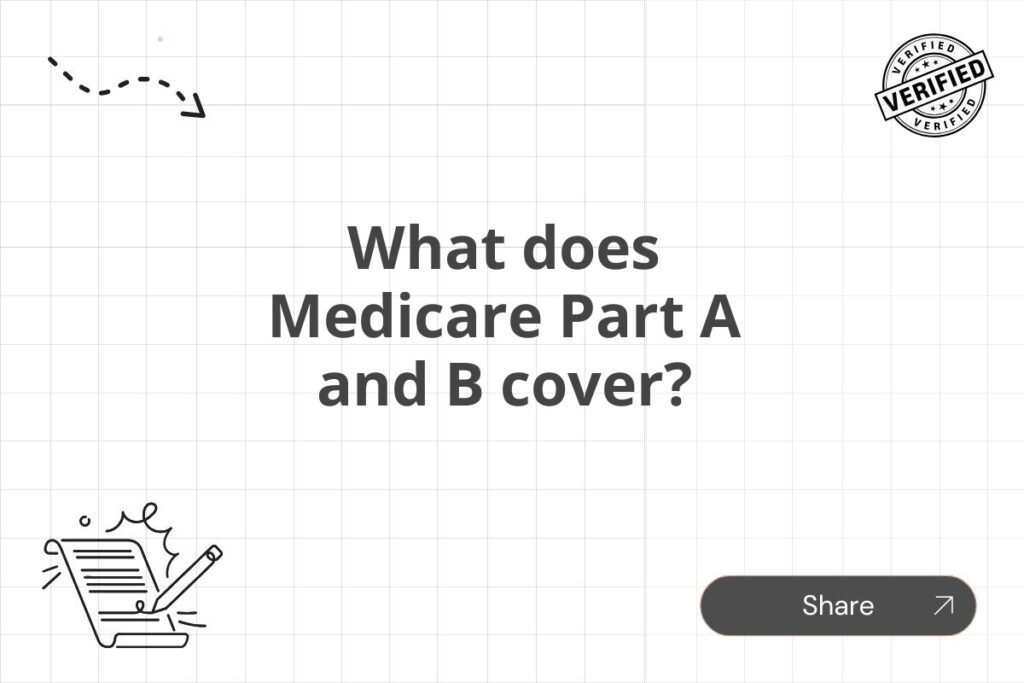Meta Description: Understanding Medicare Parts A & B coverage is crucial. This comprehensive guide details what each part covers, including hospital stays, doctor visits, and more, helping you navigate your Medicare benefits.
Navigating the complexities of Medicare can be daunting, especially when trying to understand the nuances of Part A and Part B coverage. This comprehensive guide will clarify what each part covers, providing you with a clear picture of your benefits and helping you make informed decisions about your healthcare. Understanding your coverage is essential for accessing the right care and avoiding unexpected medical bills.
Medicare, the federal health insurance program for people 65 and older and certain younger people with disabilities, is divided into four parts: A, B, C, and D. Parts A and B are the core components, forming the foundation of most Medicare beneficiaries’ coverage. While they work together, they cover different aspects of your healthcare needs.
Medicare Part A: Hospital Insurance
Medicare Part A, also known as hospital insurance, helps cover inpatient care in hospitals, skilled nursing facilities, hospice care, and some types of home healthcare. It’s largely premium-free for most people who have worked and paid Medicare taxes for a sufficient period. However, there are some costs you’ll need to be aware of, even with Part A coverage.
What Part A Covers:
- Inpatient hospital care: This includes a semi-private room, nursing care, hospital meals, and medical equipment used during your stay. However, Part A doesn’t cover every single expense. There’s a deductible you’ll have to pay for each “benefit period” (a spell of illness beginning with admission to a hospital).
- Skilled nursing facility care: Part A helps cover care in a skilled nursing facility (SNF) following a qualifying hospital stay of at least three days. This coverage usually lasts up to 100 days, but it’s important to remember there’s a daily copay after the first 20 days.
- Hospice care: If you have a terminal illness and choose hospice care, Part A covers much of the cost of this specialized care, focusing on comfort and pain management. This includes medication, nursing care, and medical equipment.
- Home healthcare: Part A can help cover home healthcare services that are medically necessary after a qualifying hospital or skilled nursing facility stay. This typically involves intermittent skilled nursing care or therapy.
What Part A Doesn’t Cover:
- Most long-term care: Part A does not cover long-term care in a nursing home if you don’t need skilled care.
- Most services provided at home without a prior hospital or skilled nursing facility stay: You generally need to have been hospitalized or in a SNF to be eligible for home healthcare under Part A.
- Private rooms (unless medically necessary): Part A generally covers a semi-private room; a private room is only covered if medically necessary.
- The full cost of care: Even with Part A coverage, you will likely have some out-of-pocket expenses, including deductibles and copayments.
Medicare Part B: Medical Insurance
Medicare Part B, also known as medical insurance, helps cover doctor visits, outpatient care, medical supplies, and preventive services. Unlike Part A, most people pay a monthly premium for Part B coverage. The premium amount depends on your income.
What Part B Covers:
- Doctor visits: This includes visits to your primary care physician, specialists, and other healthcare providers.
- Outpatient care: This covers services received outside of a hospital, such as lab tests, X-rays, and physical therapy.
- Preventive services: Part B covers many preventive services, like annual wellness visits, flu shots, and screenings for certain diseases. These are generally covered at no cost to you.
- Mental healthcare: Part B helps cover medically necessary mental healthcare services.
- Durable medical equipment (DME): This includes items like wheelchairs, walkers, and oxygen equipment, although there are certain criteria that must be met.
- Some home health care: Part B covers some home health services, but it requires a physician’s order and differs from the coverage provided under Part A.
What Part B Doesn’t Cover:
- Most vision care: While some preventive vision services might be covered, most routine vision care, such as eye exams and eyeglasses, is not covered under Part B.
- Most hearing care: Similar to vision care, routine hearing exams and hearing aids are not generally covered.
- Most dental care: Routine dental checkups and most dental procedures aren’t covered by Part B.
- Prescription drugs: Prescription drug coverage is provided through Medicare Part D, a separate part of the Medicare program.
- The full cost of services: You’ll have a monthly premium, an annual deductible, and you’ll typically pay 20% of the Medicare-approved amount for most services after meeting your deductible.
Understanding Deductibles and Co-pays
Both Part A and Part B have associated costs beyond the monthly premium for Part B. Understanding these costs is crucial to budgeting for your healthcare expenses. Part A has a deductible for each “benefit period,” while Part B has an annual deductible. Additionally, both parts may involve co-pays or coinsurance, meaning you’ll pay a portion of the cost of your services after meeting the deductible.
The specific amounts of these deductibles and co-pays can change annually, so it’s essential to check the official Medicare website or your Summary of Benefits each year to understand your current cost-sharing responsibilities.
How to Enroll in Medicare Parts A and B
Most people automatically enroll in Medicare Part A when they turn 65. Enrollment in Part B is different; you need to actively sign up during your Initial Enrollment Period (IEP), typically a seven-month period centered around your 65th birthday. There are penalties for delaying enrollment in Part B, so it’s important to enroll on time.
You can learn more about enrolling in Medicare by visiting the official Medicare website or contacting Social Security.
This guide provides a general overview of Medicare Parts A and B. The specifics of your coverage may vary depending on your individual circumstances. Always consult your Medicare Summary of Benefits, your healthcare provider, or a qualified Medicare advisor for personalized advice and clarification on your specific coverage.






















